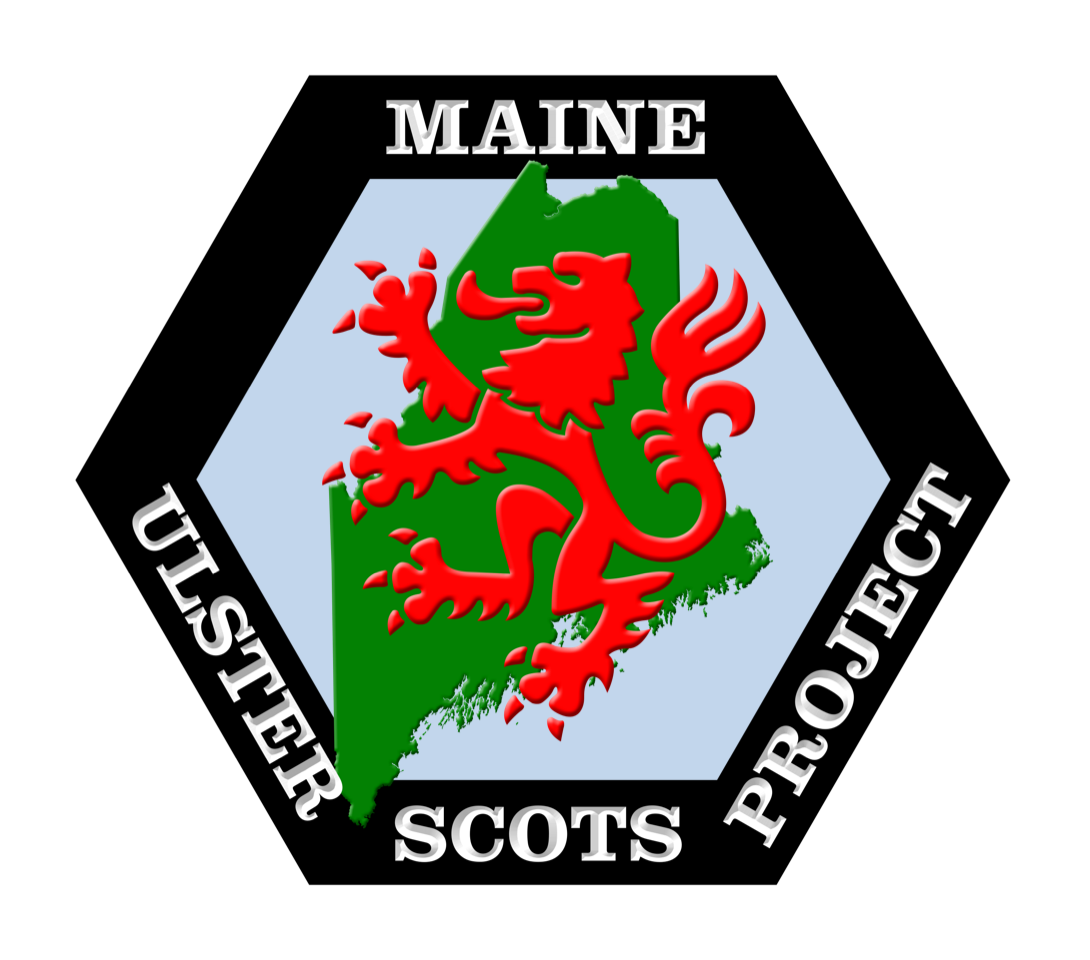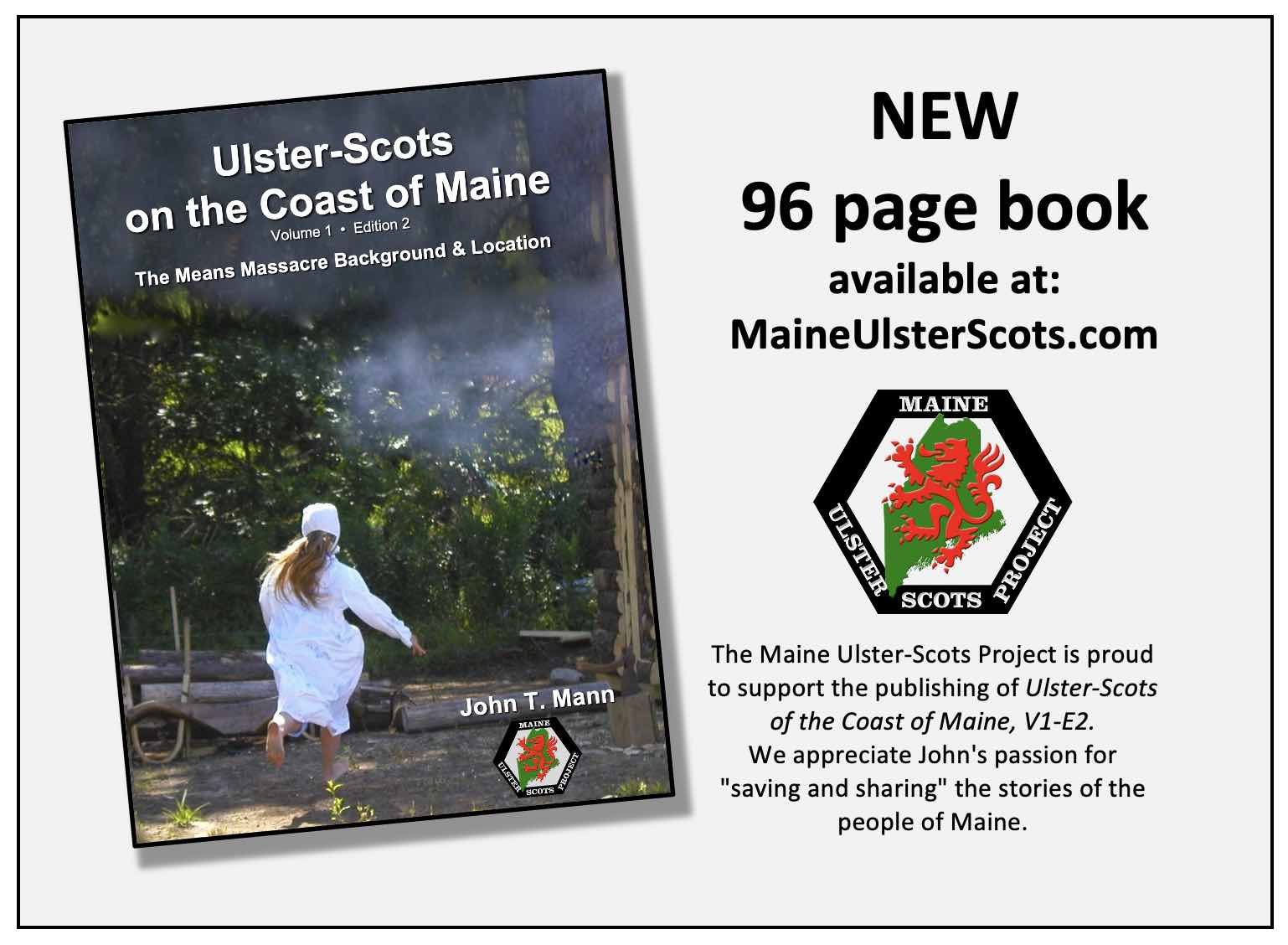The Ulster-Scots ‘Means’ homestead story gets a fresh look.
Page 2 – THE BACK STORY ~ John T. Mann, Director MUSP
On May 10, 1756, in the early days of the “French and Indian War,” the homestead farm of Thomas Means was attacked by a party of Native Americans. The raid resulted in the deaths of two members of the Means family, another wounded and one taken captive. One member of the raiding party was killed or wounded (reports differ). The conflict occurred at Flying Point in the Harraseeket District of North Yarmouth, Province of Massachusetts Bay (today’s Freeport, Maine).
Although warning had been given about Indian raids in progress, along with the recommendation that outlying settlers should shelter in their nearest garrison house, the family decided to wait until morning to go to the block house at Lower Flying Point.
The Means family lived in a log home near the shore of Maquoit Bay. The small home was occupied by seven people consisting of 33-year-old Thomas, his pregnant wife Alice, daughters Alice, 6, Jane, 3, an infant son, Robert, 16-year-old Molly (Mary) Finney, sister of the matriarch, and John Martin, a hired man.
Shortly before dawn, several of the attackers, using a log, busted open the barred door, Thomas Means was dragged from his home, and after some altercation, was shot and scalped. Molly and little Alice had been abducted. Mrs. Means, carrying her baby, barricaded the door. One of the attackers shot through a hole in the wall, killing the infant and lodging the bullet in his mother's breast. Sometime during this explosion of events, John Martin, who had been sleeping in the loft, fired his gun down through a gap in the floor timbers and wounded or killed one of the attackers causing the others to flee and allowing little Alice to escape and hide herself in a gulley behind the house. Later, after Mrs. Means had placed her dead son and husband on the only bed, three year old Jane crawled out from her hiding place in the ash pit below the floor at the back edge of the hearth and found her mother standing beside the bed grieving and believing her entire family had been lost in a matter of minutes. Little Alice arrived from her hiding place in the gulley soon after.
The Indians took Molly with them through the woods to Canada. She was given a blanket and moccasins to supplement her night-wear. Upon her arrival in Quebec, she was sold for work as a farm laborer, but was soon relocated to domestic work having proved to be unsuitable for farm work. A few months later, Captain William McLellan, of Falmouth, Maine (now Portland), was in Quebec in charge of a group of prisoners being delivered there for exchange. He had known Molly before her capture and secretly arranged for her escape. He came below her window late at night and threw her a rope which she slid down. McLellan brought her back to Falmouth on his vessel. They married shortly afterwards.
Thomas Means’ widow, Alice, later married Colonel George Rogers. They are buried at Flying Point Cemetery in Freeport. Thomas and Robert’s headstone is in Brunswick's First Parish Cemetery. His daughter, Alice, is buried at Old Harpswell Common Burying Ground, alongside her husband, Clement Skolfield, whom she married in 1773. Jane married Joseph Anderson, of Flying Point. Their headstones are at Woodlawn Cemetery on West Street in Freeport.
Thomas Means, II. was born in December 1756, a few months after the death of his father and brother, in the block house at Flying Point. He went on to achieve the rank of major in the Continental Army. He died in 1828, aged 71 or 72. His headstone is at the Mast Landing Cemetery on Upper Mast Landing Road, Freeport.
The Means massacre was the last act of resistance by the indigenous people to occur within the limits of North Yarmouth.
In 1932, a reenactment of the event was held in front of 1,000 people. Nearly all of the actors were descended from one of the Means involved. In July and August 2006, an exhibition and lecture commemorating the event was on view at Freeport's Harrington House and another reenactment was held near the original site.
During the summer of 2021, the Maine Ulster-Scots Project began an initial ground survey to identify the site of the Means family homestead and has now begun a multi-year, formal archaeological dig of the area. Work is expected to continue for several years and yield new information on the daily life and times of Ulster-Scot families living on colonial America’s Eastern Frontier.
Ulster-Scots on the Coast of Maine, The means Massacre Background & Location, Volume 1, Edition 2, By John T. Mann
First written and published by the Saint Andrews Society of Maine in 2006, Volume 1 has been updated and is now re-published and offered by the Maine Ulster-Scots Project.
John Mann (President Emeritus of the Maine Ulster-Scots Project) set out to write a report on the background and location of the Means Massacre to commemorate the 250th anniversary of the 1756 event at Flying Point on Casco Bay. The result is an in depth story of interconnected families, forced by religious, political, and economic circumstances to abandon not just one, but two homelands.




